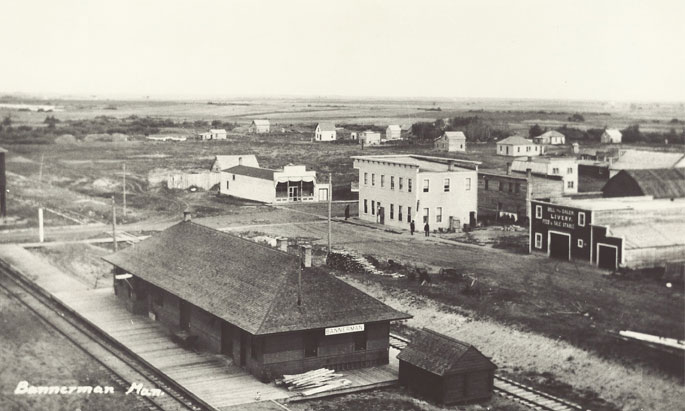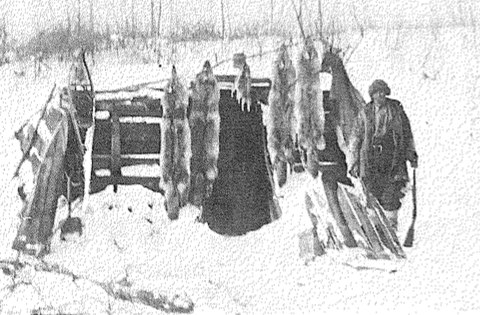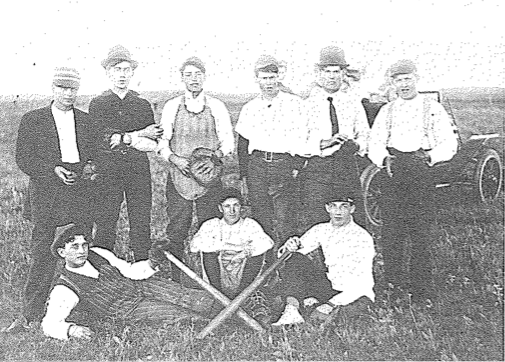| Resource
Collections / Documents |
The Village of Bannerman
Inez Pederson
A report from "Reflections - Turtle Mountain Municipality and Killarney, 1882- 1982."
(Download the pdf)
 The border town of Bannerman was situated 16 miles SW of Killarney on NE 15-1-18, three miles from the US border. The settlement of this community dates back to 1880-1881 when James Henderson Sr was the first settler to file on claims in this vicinity. His brother, Andrew, came later. In 1902 John Spafford settled on E 1129-1- 18. It was the dawn of a new era for the community when the Great Northern Railway was built in 1905. This line extended from Church's Ferry, ND to Brandon and thus Bannerman became a port of entry by rail, the first and only port west of Emerson in Manitoba. The government had a 30 year contract with GN to give daily mail service. Now pioneers could immigrate by train. With the coming of the railway there was a rush to build homes, businesses and an elevator. The railway station had two offices, one for the railroad agent and the other for the Customs and Immigration officer. Railway agents were: Jack Hemphell, 1906; Charlie Simpson, 1909, and Robert Geer, 1910-1936. The customs officers were: Phil Scott, 1906; Tom Coulter; Eldon Hannah and Charles Kelly, 1930-1936. One remembers the many services and goodwill of the Great Northern Conductor, Charles Bryant of St John, ND. Each year the circus of the Royal Canadian Shows came by the Great Northern to entertain at the Brandon summer fair. At this time the relief customs agent went to Devil's Lake to start inspection of the many passenger cars. Inspection was completed at Bannerman.  Trapper's catch. Near the railway station was the Detention House. If the customs officer was suspicious of any passenger and his papers didn't pass inspection, he was held there and sent back the next day. Major Lloyd was the first immigration agent stationed there. He patrolled the border, on the lookout for bootleggers. Jim Wright of St John patrolled the American border. The quarantine barn was located to the NW of the station. Any livestock crossing the border were held there overnight for inspection. Dr. John Little was the veterinarian at this time. To the northwest were two section houses and a water tank to fill the tender for the train. Section men were: Tom Church, Tim Livinstone, Frank Ames, Marc Clifford, Frank Sherman and Pat Jasper. The first magistrate for this community was John Balfour and the first town cop was Sam Balfour. The main street of Bannerman ran from southwest to northeast. One of the central buildings was the hotel first owned by Gene Couture. He and his brothers, Fred, Jack and Hugh built it. South of the hotel, Owen Bell and Gundar Hallen built and operated a feed and livery barn. The second owner of the hotel was PB Campbell. In 1913 Mrs. Elizabeth Cook bought the hotel and boarding house beside it. It was a large hotel with many rooms and a big dining area as well as a bar for entertainment. Rumour has it that there was some illegal gambling. There are many stories of amusing incidents in this old building. When prohibition came, the bar was closed and it was then changed to a dance hall. The livery stable to the right of the hotel was owned and operated by Mr Bill Cook who also supplied the community with milk. There was a livery team and sleigh or buggy that was always ready for hire. The lumber yard was owned by A. Bourassa from St. John. On the same side of the street was the poolroom and barber shop operated by Bill Thompson. On the north part of town was a store and post office, built by John Spafford in 1906. Joe Bate owned the first blacksmith shop. Second owner was Mr. Balmoral. Jim Melville bought this building and blacksmithed there for several years. J. Boupre owned the harness and shoe repair shop. Directly across the street from the hotel was another grocery store, built and owned by Frank Martineau in 1905. Jack Dickson and Sam Gibson also opened a store east of Martineau's. Martineau traded his store to John Hutchinson. The store was bought and sold many times; Ernie Turner, Clayton Coulter and Tom Blixhaven were all owners. Tom Blixhaven operated this store for many years. His sons farmed in the district. When the GN Railway was discontinued, he bought the station for his store. Mac and Anna McDonald, Bert and Ivy Ames, Reg and Oda Mae Arnold and Irvin and Evelyn Colp sold groceries and had the post office before business phased out. This old station was sold to John and Minnie Atchison who moved it to Lena. There was a second blacksmith shop on the east side of the street. The blacksmiths were John Neufeld, Bob Guille, Mr. Nelson, George Dickson and Pete Hildebrand. Business was poor so Mr. Mid Barber, who owned the building, had it hauled from Bannerman. Andrew Henderson started the first store and butcher shop. This was later sold to Mr. Jasper. They moved it to Wakopa and started the first beef ring in this area. Owners of the first Massey Harris dealership were Joe Bates and John Spafford. Doug Trevors also had an implement dealership in Bannerman. Because of its proximity to the border, Bannerman was well known to members of the bootlegging fraternity. Most of the early settlers felt the need of establishing a home of worship. The first church was Presbyterian; it later became the United Church. Rev. Lobb and Rev Stooke were two of the first ministers. Names of a few citizens who performed an invaluable service to the community, bear mentioning: Mrs Bessie Colp, Mrs Frances Spafford and Mrs Mary Green, all mid-wives; James Henderson Sr. an unlicensed veterinarian; Bill Harrison and Jas Henderson, first steam threshing outfit. Councillors were: Wm Davidson, Earl Jaques, Emery Jaques, Lyle Jaques, Bob Geer, Bill Parker, Bill Blixhaven, Bob Porter, Jas Henderson Jr, Roy Ringland and Jack Jaques.  Bannerman Ball team, 1909. Alva Spafford, Doug. Stroud, Dave Burrows, Bill Foster, Harry Spafford, Andy Miller, Bob Porter, Herb Miller, Willard Treleaven. Old-timers Baseball Team (1912-1935): John Mcinnis, Harvey Reide, Charles Simpson, Jack Couture and Hugh Couture, all pitchers; Alvie Spafford, catcher; Chas Hemphell and Chas Henderson, 1st base; Jesse Cain, 2nd base; Harry Spafford, 3rd base; Jim Melville, short stop; Jim Henderson Jr, centre field; Bill Dafoe, right field; Pete Melville, Dandy Melville, Bill Melville, Carl Spafford and Chas Kelly. With the closing of the GN Branch in 1936, businesses closed down and residents moved away. Rather than close the church, the districts of Desford, Wakopa and Bannerman engaged one minister. This arrangement lasted for several years but when the population became too few, the church had to close. The building was moved to Wakopa and made into a residence. Victoria Lake was the first school in the district, it was formed in 1887. Later Henderson School was built in 1905 on SW of Sec 15-1-18. Many changes took place. Change of a highway or tearing up of a branch of a railway has made ghost towns. This is what happened to Bannerman. However, we still have our heritage which we cherish and the faith, love, perseverance, sacrifices and hard work of our pioneers will not be forgotten. |
